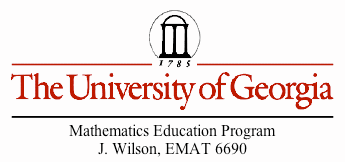
by: Doris Santarone
Geometric Transformations
Introduction
We will start the lesson on transformations with a brief Powerpoint to introduce the topic. (Click here for the Powerpoint). During the Powerpoint, there are hints of the defining criteria of each of these transformations, but no formal definitions should be written. After this brief introduction, students should get a little extra practice with the transformation by going to the National Library of Virtual Manipulatives and exploring with the 4 transformations. The links are below:
http://nlvm.usu.edu/en/nav/frames_asid_296_g_4_t_3.html (dilation)
http://nlvm.usu.edu/en/nav/frames_asid_298_g_4_t_3.html (reflection)
http://nlvm.usu.edu/en/nav/frames_asid_300_g_4_t_3.html (rotation)
http://nlvm.usu.edu/en/nav/frames_asid_302_g_4_t_3.html (translation)
Geometer's Sketchpad Exploration
The next activity is done using Geometer's Sketchpad. (Click here for the activity handout). The activity is intended to lead students through an interactive exploration of each of the transformations. The students will first have to determine how to use the technology to create each transformation, with minimal guidance. This will give the students a chance to think about what items are required to perform each transformation. What are the defining criteria of a reflection, a rotation, a translation, and a dilation? After the student has performed the transformation, then they are asked to "play" around with the sketch and find some properties of the transformation. After each transformation has been explored, the class should come together and discuss their findings. And finally, as a class, our goal is to write a formal definition of each transformation. (The definition of each will be completed before moving on to the next transformation).
Application
Geometric transformations are found all over the place...just look around!! The following Powerpoint leads you through one application of geometric transformations in quilts. This activity is one that I love because it brings in great literature, history, culture, and mathematics!!
Click here for the Powerpoint
Click here for the activity handout